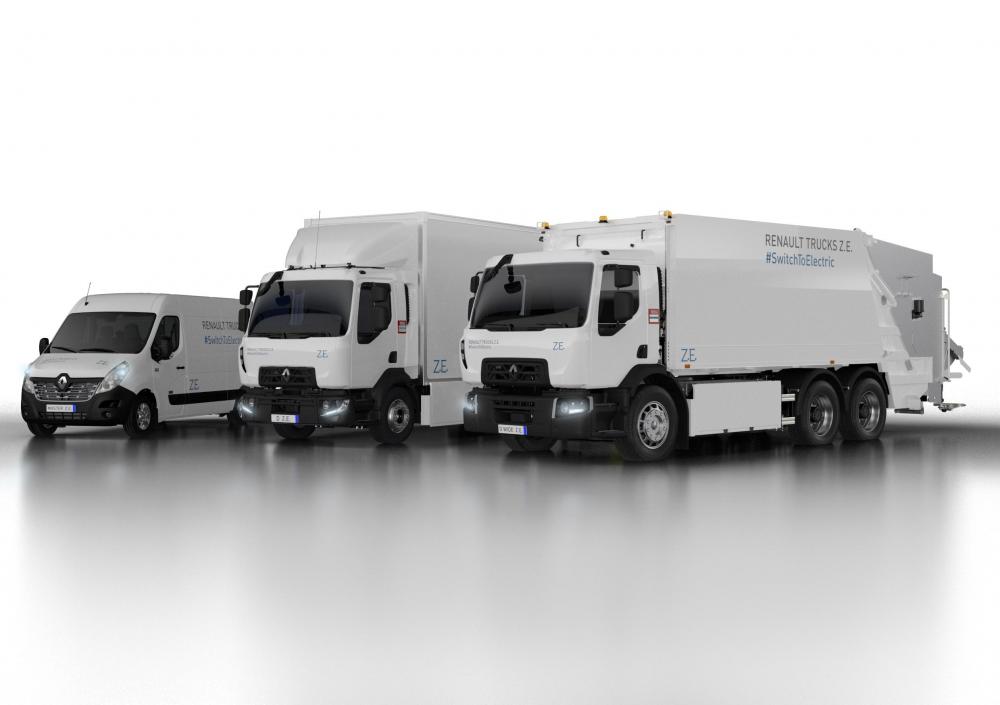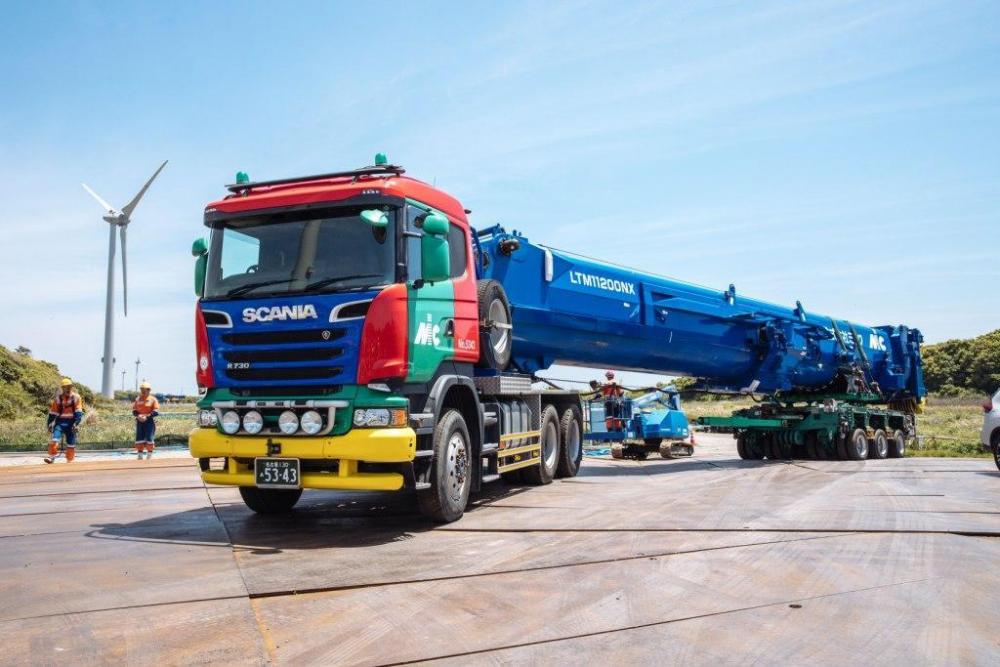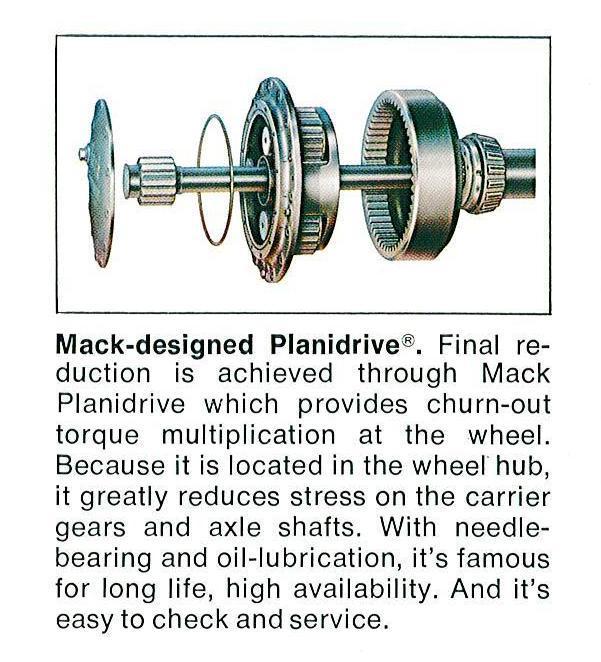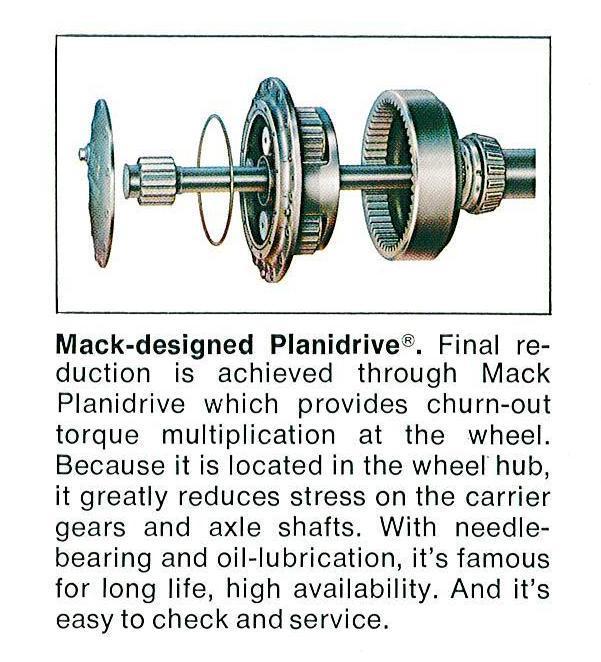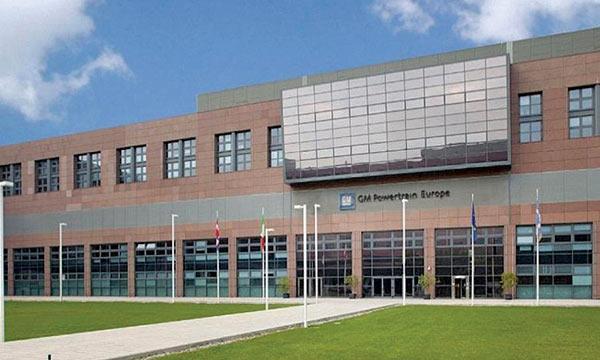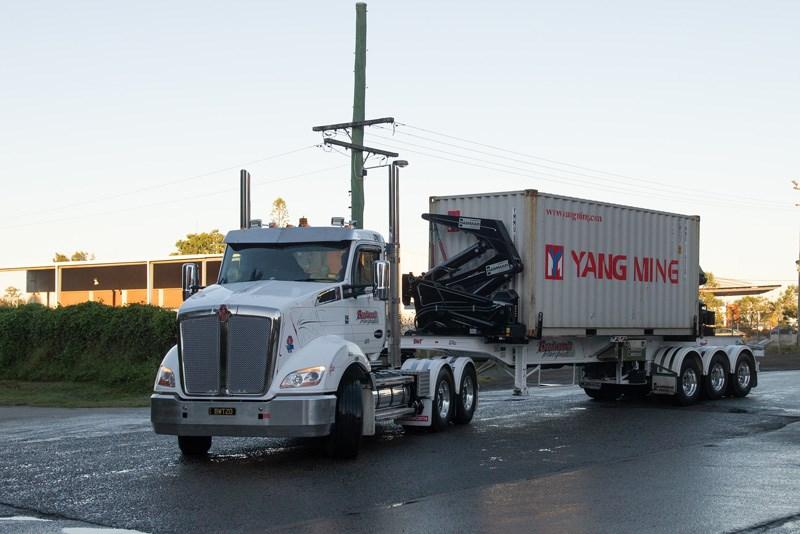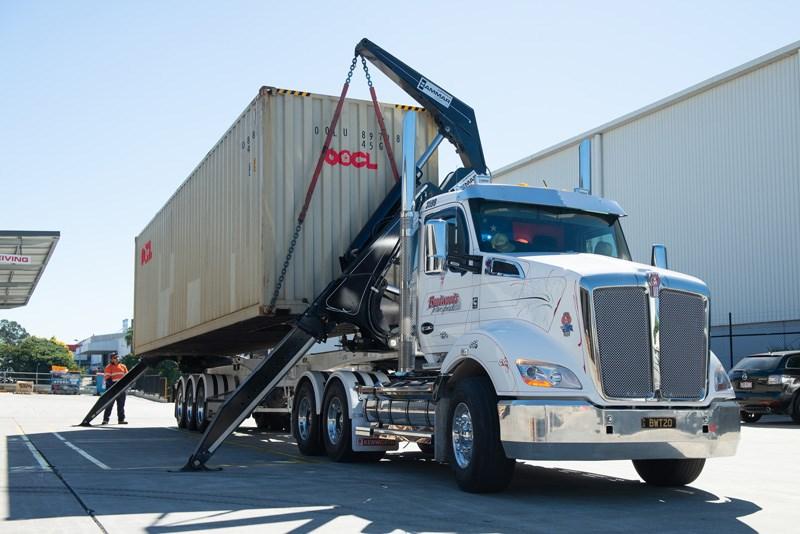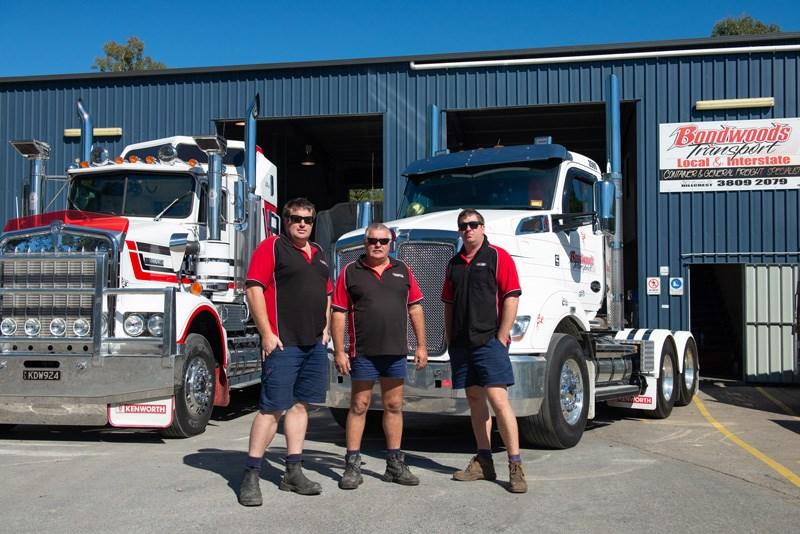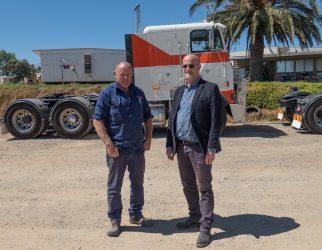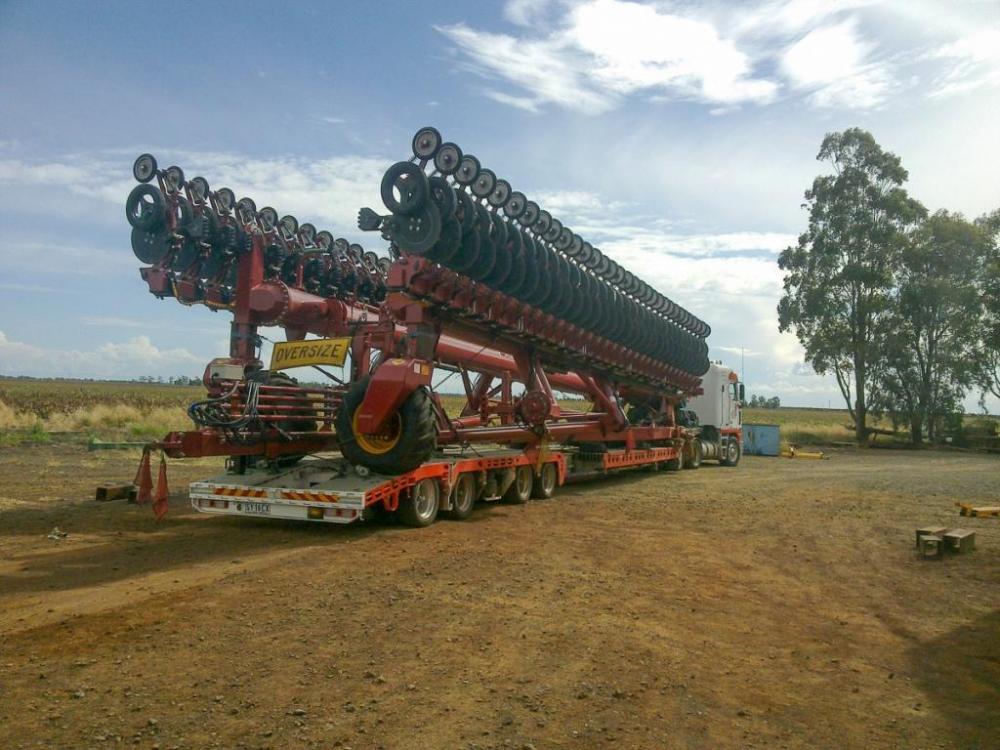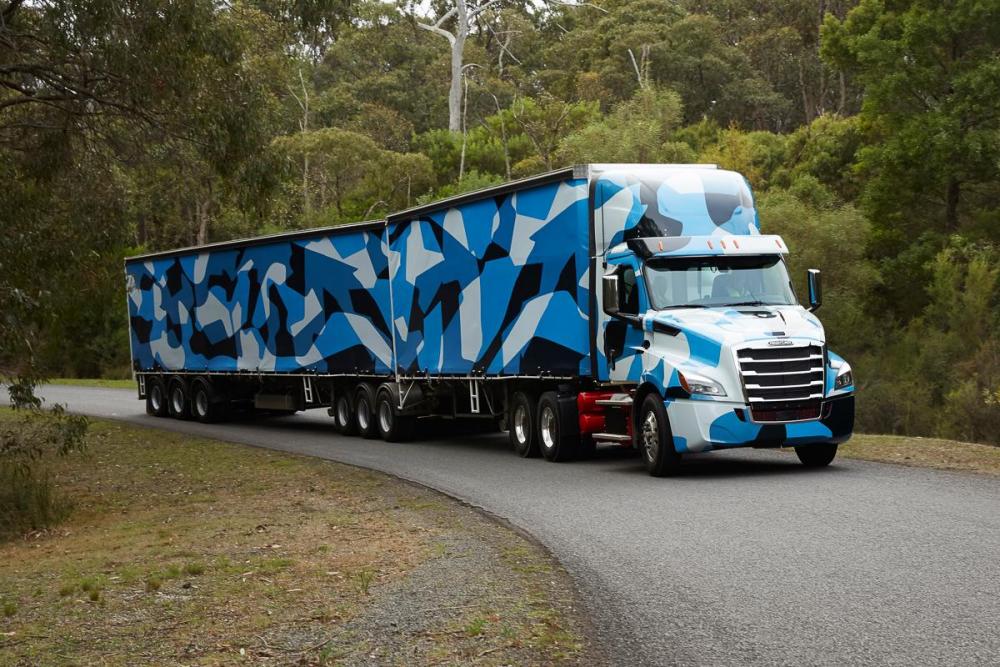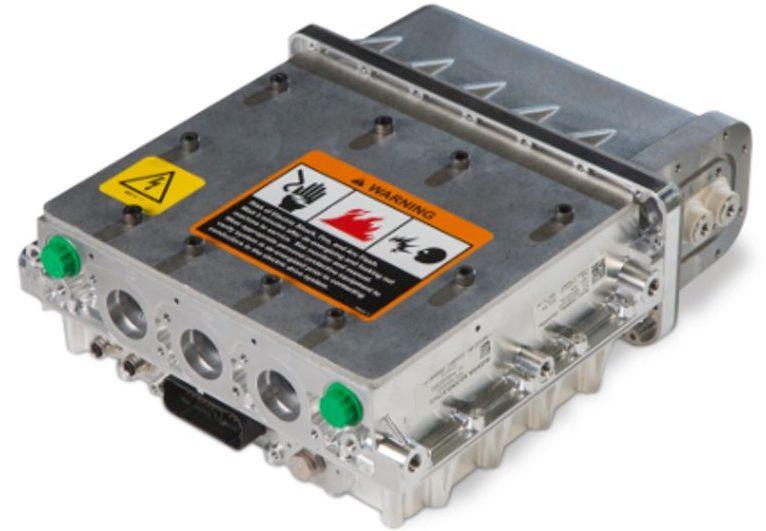
kscarbel2
Moderator-
Posts
18,550 -
Joined
-
Days Won
112
Content Type
Profiles
Forums
Gallery
Events
Blogs
BMT Wiki
Collections
Store
Everything posted by kscarbel2
-
Sounds like you want the cowl vent. Armed with your truck's model and serial number, give the good folks at Watt's Mack a call at 1-888-304-6225. If it's still available, they'll be glad to help you.
-
Renault Trucks Press Release / June 26, 2018 After ten years of experimentation under actual operating conditions with its customer-partners, Renault Trucks is pleased to unveil its second generation of all-electric vehicles: the Renault Master Z.E., Renault Trucks D Z.E. and Renault Trucks D Wide Z.E., a complete range from 3.5 to 26 tonnes ideally suited for use in the city. The Renault Trucks D and Renault Trucks D Wide Z.E. will be manufactured in the Renault Trucks plant at Blainville-sur-Orne and will arrive on the market in 2019. The Renault Master Z.E. will be available in 2018. To keep pace with the changing face of urban transport, Renault Trucks, a pioneer in the field of electromobility, is launching its second generation of electric trucks. The Renault Trucks Z.E. line-up, consisting of the Renault Master Z.E., Renault Trucks D Z.E. and Renault Trucks D Wide Z.E., ranging from 3.5 to 26 tonnes, covers the full gamut of urban uses from goods distribution and delivery to refuse collection. Renault Trucks has been preparing for the shift to electric vehicles for the past ten years. For Renault Trucks, electromobility was the obvious response to urban air quality and noise issues from the outset, as well as cut overall CO2 emissions. For over ten years, the company has been field testing electric trucks with its customer-partners in order to garner crucial information about usage, battery behaviour, charging facilities and specific maintenance requirements. These real-world tests have also enabled Renault Trucks’ customer-partners to help their own customers come to an acceptance of electric technology. Renault Trucks has over a decade of experience with all-electric trucks thanks to the Renault Maxity. “Ten years’ ago, we were the pioneers, promoting electric trucks to improve city air quality”, explains Renault Trucks President Bruno Blin “Today we can offer a range of electric vehicles with proven performance and the experts in our network are ready to help our customers transition to electromobility. Ten years’ ago we were pioneers, today we are experts.” Zero emission in use for unrestricted access The latest technological advances have made electric trucks an economically viable alternative for hauliers, leading Renault Trucks to launch a complete Z.E. range. However strict the regulations may be in urban zones, the vehicles in the Renault Trucks Z.E. operate seamlessly in compliance. They are the perfect solution to safeguard air quality and reduce congestion as they allow noise-free out-of-hours deliveries and emit neither local pollutants nor CO2. Some prominent names in freight haulage have already opted for electromobility. One such company is XPO Logistics “At XPO, we have led by example as the transport industry becomes increasingly aware of the need for alternative power”, said Luis Gomez, managing director-transport, XPO Logistics Europe. “We commend our supplier Renault Trucks for investing in the development of electric vehicles that offer a practical way to achieve zero emissions*. Renault Trucks is shaping the future of commercial transport in an evolving regulatory environment.” Suez is also following the release of the Renault Trucks Z.E range with interest. “We are delighted to see a competitive new industrial solution arrive on the market and to be able to partner with Renault Trucks,” explains Edouard Hénaut, executive director local authorities services at Suez. “This new electric truck offering will allow Suez to help its customers reduce their carbon footprint thanks to a zero-emission environmentally-friendly and silent refuse collection solution.” Renault Trucks Master Z.E., available in September 2018 The Renault Trucks Master Z.E., which will be released in September 2018, is ideal for last-mile deliveries and provides access to inner-city areas even those with strict traffic restrictions. The battery of this all-electric utility vehicle takes six hours to charge. Its loading volume is the same as a conventional diesel Renault Master as the batteries are mounted under the front seats. The Master Z.E. range comes in six variants (four panel vans and two platform cabs) designed to meet all the requirements of professionals working in urban environments. Lastly, to protect the driver and the load and keep city-dwellers safe, the Master Z.E. is outfitted with a reversing camera, reversing radar system and wide-view mirror as standard features. Renault Trucks D and Renault Trucks D Wide Z.E. for urban deliveries and refuse collection The specially designed 16 t version of the Renault Trucks D Z.E. is ideal for urban and controlled temperature deliveries. The Renault Trucks D Wide Z.E. will come in a 26 t version for efficient refuse collection. Both models will be manufactured at the Renault Trucks plant in Blainville-sur-Orne, Normandy, France in the second half of 2019. A medium-duty Renault Trucks Z.E. vehicle has an operating range of up to 300 km depending on usage and battery configuration. The battery pack is the most expensive item when buying an electric truck. For Renault Trucks, there is no question of compromising on payload or cost-effectiveness, so different operating ranges will be available tailored to customers’ exact needs. Thanks to rapid DC charging, the Renault Trucks D Z.E. and Renault Trucks D Wide Z.E. lithium-ion batteries can be fully charged in as little as one to two hours via the 150 kW Combo CCS connector. For overnight AC charging, the time to fully charge a 300-kWh battery is 12 hours. In this case, a three-phase 380V 32A industrial power socket is perfectly sufficient. For maximum flexibility in terms of usage and bodywork, the Renault Trucks D Z.E. and Renault Trucks D Wide Z.E. are equipped with a power take-off and a standard mechanical interface. TECHNICAL SPECIFICATIONS RENAULT MASTER Z.E. -Total GVW 3.1t -57 kW electric motor -Maximum torque: 225 Nm -Maximum speed: 100 km/h -Energy storage: 33 kWh lithium-ion batteries -Operating range on NEDC cycle: 200 km -Real-world operating range: up to 120 km RENAULT TRUCKS D Z.E. -Total GVW: 16t Weight: 16.7t. -Available wheelbases: 4,400 mm and 5,300 mm -185 kW electric motor (130 kW continuous output) -Maximum torque of the electric motor: 425 Nm. -Maximum torque rear axle: 16 kNm -Two-speed gear box -Energy storage: lithium-ion batteries totalling 200 to 300 kWh -Real-world operating range: up to 300 km RENAULT TRUCKS D WIDE Z.E. -GVW: 26 t Weight: 27 t. -Available wheelbase: 3,900 mm -Two electric motors with a total rating of 370 kW (260 kW continuous output) -Maximum torque of electric motors: 850 Nm -Maximum torque rear axle: 28 kNm. -Two-speed gear box -Energy storage: lithium-ion batteries, 200 kWh. -Real-world operating range: up to 200 km *in use .
-
Volvo Trucks Press Release / June 26, 2018 With the launch of Volvo Connect – a single interface for digital services and functions– Volvo Trucks hopes to enable smoother and more efficient transport operations. By gathering all trucks and other assets as well as Volvo and partner services in one place, the new platform will make it even easier for customers to access the full benefits of digitalisation and connectivity. .
-
Vibration that 2 mechanics and Mack dealer can’t figure out
kscarbel2 replied to RobM626's topic in Engine and Transmission
http://hr.mckenzietank.com/maint/bulletins/45-sb212025.pdf -
Trump and Immigration (Illegal Immigrants in the US)
kscarbel2 replied to kscarbel2's topic in Odds and Ends
Hungary understands how to realistically address illegal migration. . -
Trump and Immigration (Illegal Immigrants in the US)
kscarbel2 replied to kscarbel2's topic in Odds and Ends
17 states sue Trump administration over [illegal immigrant] family separations Associated Press / June 26, 2018 SEATTLE — Seventeen states, including Washington, New York and California, sued President Donald Trump’s administration Tuesday in an effort to force officials to reunite [illegal immigrant] migrant families who have been separated at the U.S.-Mexico border. The states, all of which are led by Democratic attorneys general, joined Washington, D.C., in filing the lawsuit in U.S. District Court in Seattle. It’s the first legal challenge by states over the practice. “The administration’s practice of separating [illegal immigrant] families is cruel, plain and simple,” New Jersey Attorney General Gurbir Grewal said in an emailed statement. “Every day, it seems like the administration is issuing new, contradictory policies and relying on new, contradictory justifications. But we can’t forget: the lives of real people [illegal immigrants] hang in the balance.” Immigration authorities have separated about 2,300 [illegal immigrant] children from their [illegal immigrant] parents in recent weeks, sparking global outrage as images and recordings of weeping children emerged. Many parents [illegal immigrant] are in custody thousands of miles from their [illegal immigrant] children, whom they have not been able to see and have rarely spoken to for a month or more. After falsely blaming Democrats for the separations and insisting that only Congress could fix the issue, the president last week issued an executive order designed to end the practice under his “zero tolerance” policy, which prosecutes adults who come to the U.S. illegally. But the states say his order is riddled with caveats and fails to reunite [illegal immigrant] parents and children who have already been torn apart. They accuse the administration of denying the [illegal immigrant] parents and children due process; denying the [illegal] immigrants their right [???] to seek asylum; and being arbitrary in applying the policy. A U.S. judge in San Diego already is considering whether to issue a nationwide injunction sought by the American Civil Liberties Union that would order the administration to reunite the separated [illegal immigrant] children with their [illegal immigrant] parents. The states that sued are Massachusetts, California, Delaware, Iowa, Illinois, Maryland, Minnesota, New Jersey, New Mexico, New York, North Carolina, Oregon, Pennsylvania, Rhode Island, Vermont, Virginia and Washington. -
Scania Group Press Release / June 25, 2018 Wind power currently only accounts for a small fraction of Japan’s energy supply, but it’s a share which will increase substantially in the years ahead. But, due to their sheer size, installing wind turbine towers is a highly challenging process. In Japan, as in other countries, this industry relies on the most powerful trucks available. The Mic Group fields two Scania 6×6 tractor units for its daunting transport operations. At Omaezaki Port, 280 kilometres south of Tokyo, the specialised firm deals with four wind turbine towers. The pillar is divided into five parts and the height of the base alone reaches 78 metres, with a diameter exceeding four metres and rotors that are 82 metres wide. A window of opportunity Japan imports most of the wind turbine parts from abroad, and these are shipped to the closest port to the wind power location and subsequently transported there by road. Despite dividing the load, the parts still come to 20 metres in length, 3.4 metres in width and have a total vehicle weight of more than 44 tonnes. The transport window of opportunity is from 9 p.m. to 6 a.m. With its oversized load the 20-kilometre journey takes between one-and-a-half to two hours and the haulier can manage at most two return trips in the available slot. Accompanying the transport are three lead cars, with another two at the rear. Mic Group driver Masao Oiwa praised the R730 V8-powered Scania truck’s ability to master this huge challenge. “Overall the ride is very smooth and there is sufficient power from the outset. The retarder is wonderful and the brakes perform really well.” .
-
The these folks are having a civilized conversation about current events, which fits exactly into the Odds & Ends thread. “This forum is for non-truck related topics. Talk about interesting websites, current events, tell jokes, post funny photos...etc.”
-
Why are these visa-less want-to-be immigrants allowed in period? Why aren't they refused entry? No visa.....no entry......it's that simple. Cross our border into the U.S. illegally.....now you're a criminal.......such people should then be permanently banned from entry. Meanwhile, thousands of people around the world are legally applying for immigrant visas at U.S. embassies.
-
Political parties should be banned, as they only serve to distract elected government employees from their inherent duties. Term limits should be mandatory.
-
Europe Retaliates Against Trump Tariffs Jack Ewing, The New York Times / June 21, 2018 GOTEBORG, Sweden — The European Union fought back on Friday against the Trump administration’s tariffs, slapping penalties on an array of American products that target the president’s political base, like bourbon, motorcycles and orange juice. The European counterattack on $3.2 billion of goods, a response to the administration’s measures on steel and aluminum imports, adds another front to a trade war that has engulfed allies and adversaries around the world. China and Mexico have already retaliated with their own tariffs, and Canada, Japan and Turkey are readying similar offensives. The risk of escalation is high since Mr. Trump has promised even more tariffs. Taking particular aim at German car manufacturers, the president has started an investigation into automobile imports to determine whether they pose a national security concern, the same justification used for his metal tariffs. “You look at the European Union,” the president told a crowd in Duluth, Minn., on Wednesday. “They put up barriers so that we can’t sell our farm products in. And yet they sell Mercedes and BMW, and the cars come in by the millions. And we hardly tax them at all.” He added in a tweet on Friday that he would place a 20 percent tariff on European cars, if the barriers “are not soon broken down.” The United States is fighting from a position of strength, with the American economy on track for one of its strongest years in a decade. Europe doesn’t have the same defenses. Growth in the region is slowing, and that weakness has been compounded by political turmoil in Italy and Germany, as well as Britain ’s decision to leave the European Union. But in a trade war no sides are left unscathed. Although Mr. Trump has sought to exert pressure on other countries, the global nature of supply chains means the tit-for-tat tariffs are ricocheting in unexpected ways and may ultimately cost jobs in the United States. Sales of Mercedes S.U.V.s, made in Alabama by the German automaker Daimler, could be hit by the American trade dispute with China. The Swedish manufacturer Volvo faces rising prices on the imported steel it uses at its Mack Truck factory outside Allentown, Pa. The path to reconciliation is shrouded in uncertainty, creating the potential for broader strain in the global economy. While the Trump administration has sought to use economic force to exert concessions, the successive drumbeat of attacks has left little time to negotiate. Formal trade talks between Brussels and Washington have broken down, although informal channels have remained open. The European Commission, the European Union’s administrative arm, applied its sanctions more than a week earlier than expected, in what analysts said was a show of strength. “It’s a signal that the E.U. is striking back and taking this seriously,” said Holger Schmieding, chief economist at Berenberg Bank in London . As Mr. Trump pursues a nationalistic agenda, leaders in Europe and elsewhere are eager to demonstrate that they will continue to dismantle barriers to commerce, with or without the United States. Cecilia Malmstrom, the European commissioner for trade, was in New Zealand on Thursday negotiating a free-trade pact with the government there, the latest in a series of treaties signed or in the works, including ones with Japan, Canada and Australia. “We did everything we could to avoid this situation, but now we have no choice but to respond,” Ms. Malmstrom said in a speech in Wellington, New Zealand. “The E.U. has a responsibility to stand up for open global trade.” The new slate of European tariffs focuses on products that tend to be manufactured in Republican strongholds: whiskey and playing cards from Kentucky, recreational boats from Florida and rice from Arkansas. But trade wars don’t play out that neatly. It’s not easy to strike precise targets without collateral damage. Take the Mack Truck factory in Pennsylvania. Mack may be a quintessential American brand, but it’s owned by Volvo Group, which is based in this seaport on Sweden’s southwestern coast. The Mack plant uses specially treated steel imported from Europe. American substitutes are not readily available, if at all [Impossible, or shocking, to believe]. That means the Allentown factory has to pay 25 percent more for some kinds of steel, putting it at a disadvantage with its competitors who manufacture in Mexico and can get the same high-quality steel without paying the Trump tariffs. At least for the moment, vehicles made in Mexico are not subject to tariffs when they are imported into the United States. Billy Joel sang about Allentown as the city where “they’re closing all the factories down.” The Mack Truck factory, in the suburb of Lower Macungie Township , has been an exception. It is “packed with orders,” said Martin Lundstedt, the chief executive of Volvo Group, a manufacturer of trucks, buses and heavy equipment that is separate from the company that makes Volvo cars. But he worried that demand could slip if costs in the United States rose and the trade dispute triggered an economic slowdown. “Yes, it will affect us, and we need to live with it,” Mr. Lundstedt said. “It could be that if you have production in the U.S. you are punished.” It’s a similar concern for ABB, a supplier of heavy electrical equipment based in Zurich. ABB makes electrical transformers in South Boston, Va., and Crystal Springs, Miss. “We use a very specific kind of steel,” said Ulrich Spiesshofer, the chief executive of ABB. “The capacity and the number of players for that kind of steel is very limited. The steel that we import from other places is being punished.” Eventually the competitiveness of the United States plants could suffer, Mr. Spiesshofer said. Daimler, the maker of Mercedes cars, has already been caught in the crossfire between the United States and China. The company issued a profit warning on Wednesday, in part blaming tit-for-tat tariffs for a slump in the sales of S.U.V.s, which are built in Tuscaloosa, Ala. In retaliation for tariffs imposed by the United States on Chinese goods, China has threatened to increase penalties on American cars to 40 percent from 15 percent. That would hurt sales in the huge Chinese market by raising sticker prices for Mercedeses from Alabama as well as BMWs made in Spartanburg, S.C. “Fewer than expected S.U.V. sales and higher than expected costs — not completely passed on to the customers — must be assumed because of increased import tariffs for U.S. vehicles into the Chinese market,” Daimler said in a statement late Wednesday. Last year, BMW exported about 80,000 vehicles to China, including its X5 S.U.V., from the Spartanburg plant, its largest factory in the world. BMW said in a statement on Thursday that it did not need to revise its outlook for profit because of trade tensions, but the company added that it “continues to observe international developments closely.” Shares of major German and American carmakers fell sharply Thursday on worries of a trade-related slowdown. Daimler shares closed off more than 4 percent in Frankfurt trading, and BMW shares slipped 3 percent. If the trade conflict continues, companies could consider relocating assembly lines to other countries, leading to job losses in the United States. BMW already has factories in South Africa and China, among other countries. Carmakers would not make such a decision lightly. Moving manufacturing is expensive and takes years to carry out. The German carmakers continue to hope that the conflict will blow over and perhaps even provide a catalyst for removing trade barriers with the United States. Currently the United States charges a 2.5 percent levy on imported foreign cars while Europe imposes a tariff of 10 percent on cars from the United States. German automakers would be happy if tariffs fell to zero in both directions, though only as part of a broad trade pact, Eckehart Rotter, a spokesman for the German Association of the Automotive Industry, said Thursday. Ironically, the tariffs could have a small — if somewhat short-lived — upside for Europe. Local steel and aluminum may eventually fall in price because producers in countries like Russia or Japan will divert supplies that otherwise would have gone to the United States, creating a glut in the market. That would be bad for steel producers but good for machinery makers and other companies that use a lot of steel, potentially giving them an edge over their American competitors in overseas markets. But any benefits for Europe would be erased by a sizable disruption to global commerce. The biggest problem for companies, regardless of nationality, is that they don’t know how much more the trade conflict will escalate. The uncertainty may already be gnawing on growth. “For the first time we’re hearing about decisions to postpone investment, postpone hiring, postpone making decisions,” Jerome H. Powell, the chairman of the Federal Reserve, said during a panel discussion with other central bankers in Sintra, Portugal, on Wednesday. “That’s a new thing.”
-
Relax David. Remember, most of what we hear about is sent to the masses for a purpose, to steer them in one direction or another, or for disinformation campaigns. We only know about 15 percent of what is really going on. I truly believe the government that the masses see is largely for show.......there is a deeper state, which doesn't answer to the people, that actually pushes the buttons and pulls the levers......and big business is involved.
-
Volkswagen Truck & Bus says no decision yet on listing
kscarbel2 replied to kscarbel2's topic in Trucking News
VW already has a new plant in Poland producing an all-new VW-designed Crafter, and it's very good (The previous Crafter was based on the Sprinter, purchased from Daimler and VW-powered). But the Transporter and Caddy are nearing the end of their life cycle......that might be the catalyst for exploratory talks with Ford. -
The Mack LRVSWs made their run in 1956. This video shows Alaska Freight Lines in action one year earlier in 1955. .
-
-
At the time that Volvo acquired Mack Trucks, our own planetary hub reduction axle design, "Planidrive", was long since out of production. Badged as SR70 and SR80, high-performing Renault planetary hub reduction axles were offered for many years, pre-Volvo. https://www.bigmacktrucks.com/topic/30384-heavy-duty-macks/ Finnish Sisu brand planetary hub reduction axles may be special ordered today for severe service applications. .
-
GM bets on a diesel revival Nick Gibbs, Automotive News / June 23, 2018 TURIN — This northern Italian industrial city is famous for being the home of Fiat, and therefore FCA, but it's also home to a key operation in General Motors' drive to reduce fuel consumption in its combustion engines in the U.S. and globally. GM Powertrain Torino is where the automaker develops its new diesel powertrains, and despite selling the bulk of its European operations to France's PSA Group last year, GM is holding on to and even investing in the Turin technical center as its ambitions for the fuel grow in markets outside of Europe. "We have an important strategy around diesel. We are working to keep [U.S. sales] increasing," Pierpaolo Antonioli, head of GM's Turin development center, said on the sidelines of the Automotive News Europe Congress here this month. GM Powertrain Torino, born out of the ashes of the failed GM-Fiat powertrain alliance, employs 750 people, including some of the industry's most capable diesel engineers. Among its creations are the Duramax 3.0-liter straight-six diesel engine announced in January for the new Chevrolet Silverado full-size pick-up, which is expected to crack 30 mpg. The unit is the first to be built using GM's new diesel engine architecture developed in Italy that follows on from the modular Cylinder Set Strategy first used in gasoline engines, Antonioli said. GM said it sold more than 600,000 diesels globally in 2017 — 360,000 by the GM group, according to LMC Automotive, and the rest by Opel. GM also sold diesels in the U.S., Thailand, Brazil, Australia, India and South Korea. Chevrolet claims it offers more diesel models than any other brand in the U.S., with diesel variants available for the Equinox, Cruze, Colorado, Express, Silverado 1500 and Silverado HD. GM currently buys its Turin-developed four-cylinder diesel engines for the Equinox and Cruze from PSA* following Opel's sale. Those could be replaced by a new variant of the CSS diesel range expected next year. Antonioli said the CSS architecture includes four-cylinder and three-cylinder diesels. Antonioli said he was confident diesel would bounce back from the damage caused by revelations that VW and other makers were cheating diesel emissions tests, and GM has said it hopes to capture some disaffected VW buyers as the brand shifts away from diesel. "Everybody was caught a little bit by surprise by the scandal," he said. "It took time to react and start to say that diesel is not the dirty guy. In my opinion its reputation can be recovered." * Groupe PSA is a French manufacturer of automobiles and motorcycles sold under the Peugeot, Citroën, DS, Opel and Vauxhall brands. .
-
http://www.gordonbrothers.com/assets-for-sale/assets/2018/rivet/rivet-photo-gallery#
- 1 reply
-
- 2
-

-
Owner-Driver / June 15, 2018 After decades of buying second-hand trucks, the Woods family changed direction and bought their first newie – a Kenworth T610. Warren Aitken gets the feedback from Jamie Woods and driver Chris Faaaliga The old saying is ‘you can’t teach an old dog new tricks’. But while that might be the case for actual old dogs, the same isn’t true of those ‘old dogs’ in the transport industry. To survive in this industry ‘old dogs’ have to keep up with what’s new in the industry as well as mastering everything they’ve learnt from previous years. For my own safety though I’m going to drop the ‘old dog’ analogy because those oldies also know ways of punishing those who call them ‘old dogs.’ More to the point, when you’ve learnt the new tricks and grown your transport business from a ‘two trucks between mates’ kind of business into a flourishing 34 truck and 75 trailer fleet, what new things are there left to try? Well, for Kim Woods, his wife Diane and sons Jamie and Chris, the one thing they could try was buying their first brand new truck. Kim formed Brisbane-based Bondwoods Transport in 1994 with a mate. Back before Facebook, Google and Ebay filled our days, Kim was running 48ft boxes on and off the rail for Cubico/Boxcar. Kim and another contractor where kept flat out with local work. When Cubico mentioned bringing in another subbie, the two men bought another truck and formed Bondwoods Transport. For 14 years Bondwoods built a solid reputation based on both men’s old school values of service and reliability. In 2008 Kim bought out his partner and it became a one-family operation. "It was too large a job to change the name," explains Kim’s son Jamie. "So we just kept Bondwoods." During those first 14 years Cubico was bought out, the company that bought Cubico was then bought out, then that company was bought out and then that company was also bought out and then … well, you get the gist. There had been many changes of management but Bondwoods kept supplying their reliable service and the work kept coming. Bondwoods did meet on hard times when the Global Financial Crisis hit in 2007. They lost a chunk of work with several trucks having to be sold and the fleet downsized to eight prime movers. Coincidently 2007 was also the year Jamie joined the Bondwoods’ driving team (I’m not saying he caused the GFC, but the timing is interesting). As 2008 disappeared in the rear-view mirrors the Bondwoods’ team was starting to replenish their workload. Over the next decade the business set about building a solid reputation with all its customers. In 10 years they’ve more than quadrupled their fleet, although Jamie admits they’ve never gone chasing work and have looked taking anyone else’s work either. The customers come to them. "Our growth is run by the growth of our customers," Jamie says. Out of the driver’s seat Jamie managed six years in a driver’s seat before the business became just too busy for him not to suit up and get in the office. The same thing happened earlier this year when younger brother Chris ‘Boof’ Woods had to retire his seat to take over the interstate operations. While the move to a comfy office chair was to take care of the day-to-day operations, one of the other aspects Jamie was instrumental in was increasing the presentation of the Bondwoods’ fleet. "There’s nothing real flash about them," Jamie humbly explains. "Just a bit of stainless and some pin striping." Although when that pin striping is done by the boys at Truck Writers in Caboolture, you know it’s going to stand out. Jamie freely admits that the other reason the trucks stand out is his drivers. The pride they take in their gear shows on the road, which is a case in point. Jamie happily regales a recent story of a customer who was on his way down to the port of Brisbane for a meeting with his current freight forwarder that he was having issues with. "He saw a couple of our trucks in a line of 10 or so trucks and they stood out. Next thing he’s on the phone and Bondwoods have another client to look after." While their workload has increased from local box carting to general freight, steel, produce and everything in between, the roads travelled now go anywhere from Melbourne to Mackay. However one thing has always stayed the same – the purchase of second hand trucks. "It’s always been the way Dad modelled the business," Jamie tells me. "Originally it was to keep the costs down, we did a lot of subcontract work and the money just wasn’t there. "The flipside of buying second hand is having to allow for more maintenance, so having two fulltime mechanics on board meant everything was looked after." As far as what second hand trucks they purchased, Kim wanted to keep variety in the fleet. There’s K104s, K200s, T401s, 404s, 404 SARs, 408s, 409s, a T650, a 904, a 604 and a 608 .It’s a definite variety of Kenworth models. "Nothing stands up better than a Kenworth" is not just Jamie’s opinion, but that of the entire family. "They put up with the harshest conditions and they’re brilliant round town," he continues. If you look closely in the yard though, you will see a couple of bonnets without a KW emblem on them. Enter the T610 In late 2017 it was time for a big change and Bondwoods very first brand new truck arrived. The decision came about through the increased workload, coupled with the struggle to find good second-hand trucks that weren’t housing the older EGR motors, an engine Bondwoods preferred to stay away from. Dave Constable from Brown and Hurley’s Yatala outlet was the man to get Kim and his boys into their very first new truck. "He’s been brilliant!" Jamie says. Even though they’d never bought anything from him previously, Dave was always popping in for a chat, checking on the business, going as far as dropping off a gift when Jamie’s wife had their first baby. "When the decision was made it was a no brainer," Jamie adds. "He’d put the legwork in." Dave brought round a stock truck which was white with a black chassis. Another bulls-eye in Bondwoods’ book so Dave had to Uber home. Done deal! The new T610, powered by a Cummins X15, was immediately sent off to Truck Writers to get some scroll work done. Soon after, it popped around the corner to Leeroy’s Stainless for a little bling before returning home where a new visor from Rocklea Truck Electrical was fitted. One of the other notable attributes of Kim and the Bondwoods management team is their willingness to hire young and inexperienced workers trying to get into the transport industry. Jamie admits to enjoying putting the time and training into the new recruits. "We’ve got three or four guys here under the age of 22. They’re all keen, they love their trucks; why wouldn’t you want them here? "They can’t wait to get here Monday morning; they’re the sort of people you want." One of those graduates of the Bondwoods’ school of ‘we’ll cart everything’ is the man who got the new keys and the first ever new truck smell at Bondwoods – Chris ‘Coco’ Faaaliga. Power of the X15 Chris started with Bondwoods over six years ago and while his job now predominantly involves the new swing lift work, there’s nothing in the company he hasn’t tried. Local DC deliveries to steel, changeovers to dock work, Chris has learned more ropes than a sailing class. Along the way he’s taken a lot of pride in each vehicle he’s had. The last 409 he had looked in better condition than my car, and I clean my car a lot. Jamie admitted that even though Chris works six days a week, the T610 looks like it’s just rolled out of the factory. So how does the new T610 handle the round town work? Piece of cake, not just any cake either, one of those three-tiered chocolate and banana cake creations. Chris loves it, admitting the power of the X15 makes it a breeze. His laugh borders on maniacal when he recants cruising past other trucks when he’s fully loaded. In terms of manoeuvrability and vision, two vitally important attributes when it comes to round town work, the same praise flows from Chris. He had been forewarned of the shaking of the single arm mirrors, but in typical Coco fashion he informs me, "Those kinda mirrors normally shake, but nope, that one’s good … maybe they shake when you keep hitting trees a lot!" While the new Kenworth T610s have proven their worth out and about on the Australian highways it was great to see how well it performed in more confined spaces. The power of the X15 is evident pulling away time and again from the lights, the turning circle has lost nothing to its younger 4-0 models and the drop away bonnet and large mirrors means you’ve got to pull some real David Copperfield stuff to hide from the driver’s view. It’s taken 24 years for Bondwoods to get their first truck, and the new Kenworth T610 has definitely made them rethink waiting another 24 for the next one. .
-
Diesel News Australia / June 2018 A South Australian heavy haulage outfit is planning the return of the Freightliner FLB. Ken Pitt, All Size Equipment Transport (ASET) Managing Director has moved away from a policy of buying new trucks as he says he hasn’t found a specification available in a new truck that can match what he can achieve in terms of configuration and mass. ASET are buying old Freightliner FLB trucks and rebuilding them to suit the tasks they are undertaking. According to Ken, the FLB has a number of advantages as a platform on which to build. It has a front axle set well forward, giving any combination good axle spread, helping the loads stay inside the restrictive oversize over-mass envelope. The tare weight of a finished FLB can be around seven tonnes, whereas a brand new equivalent, like a Freightliner Argosy or Kenworth K200 will come in around 10 tonnes. This three tonnes, again, helps ASET keep loads within the envelope. “We can get the FLBs down below 7 tonnes tare, and they are still a 70 to 90 tonne GCM truck,” says Ken. ASET have found a sweet spot where their combination will be able to handle a load on a normal semi, but many of their competitors will have to use a converter dolly to spread the weight from the front of the trailer. However, Ken does admit to the necessity of bringing some new trucks into the fleet and is looking at the Argosy as the best alternative, with its dimensions more suited to the precise needs of the operation. Argosy models have been customised on arrival at the ASET yard. The suspensions are taken off and rearranged to suit the lower profile tyres the company fits on standard wheels. The business runs with five mechanics. They handle a varied workload, not only servicing trucks and trailers, but also working on building new equipment. One specialist rebuilds all of the engines, gearboxes and diffs. There are two regulars working to manufacture trailers, but all of the team are multi-skilled. When work gets busy, those building trailers may be out driving trucks. When things are quiet, the trailer manufacturing team grows. Learning from the US “I spent some time holidaying in the US and it was a real eye-opener,” says Ken. “I got a car, went on the road and had a look at everything. America make some very low stuff. Their infrastructure in the cities lets them get pretty low, in stuff like car carriers. I was taking photos underneath the trailers. Some you couldn’t get underneath. “I came across a wrecker in Indianapolis and he had 30 acres of stuff. I spent a weekend hunting around in there. Looking at all the bits they fit there but doesn’t come to Australia. I have now persuaded Freightliner to bring these different suspension pedestals into Australia.” ASET do not use the 19 inch rims favoured by the Americans. Instead, Ken sticks with 22 inch rims but fits ultra low tyres sourced from Europe. The combination of the two actually allow the truck to sit lower than on 19 inch wheels. The trailers are fitted with 19 inch rims with low profile tyres. This allows room for conventional brake set ups to be used, but keeps trailer height low. In terms of tyre wear, ASET have found the tyres don’t last as long as conventional ones. However, the ability of this gear to stay under the 4.9, 4.6 and 4.3 metre height thresholds when loaded is reckoned to pay-off in terms of cost. The disadvantages of running with these adaptations include more wear and changing diff ratios, and having to carry spares at all times. Going to the lower profiles will change a 3.7:1 ratio to one of approximately 3.2:1. This means the carrier has to be changed to keep performance and fuel economy balanced. .
-
Diesel News Australia / June 2018 A presentation in Melbourne this week has confirmed the Freightliner Cascadia is in Australia to commence a comprehensive testing and evaluation program in the lead up to its launch in Australia in early 2020. Ever since the introduction of the Cascadia on the US market, back in 2009, there has been a lot of speculation about if and when the model would be introduced to Australia. There was talk of the truck being unsuitable for Australia. In North America it is sold as a mass-produced highway truck used as a generic prime mover to haul the standard trailers on smooth interstate highways at masses below 40 tonnes. Freightliner in Australia had persisted with the older model designs like the Argosy, Coronado and Columbia. These are based on a vehicle platform which predates the development of the Cascadia, a design which integrates elements which are common across the Daimler truck family. The success of the Cascadia in North America has seen Freightliner regain number one status right across the heavier end of the market, as it continues to grow market share to over 40 per cent in the heavy duty prime mover market. US interstates are populated with processions of Cascadias with a few competitor brands sprinkled into the mix. Initially, the Cascadia is to be tested in its left hand drive form. This is an opportunity to test aspects like driveline and running gear while the right hand drive aspect can be developed and refined. The second wave of evaluation trucks will be right hand drive as Freightliner gets closer to the final specifications required to suit Aussie conditions. As we are so early in the process, Freightliner are unwilling to be tied down to the specifics of what will be offered to the Australian truck buyer in 2020. However, there are some concrete factors which the company is willing to divulge. The engines on offer will be the Detroit DD13 and DD16. Top power on the 16 litre is going to be over 600 hp, but how far over is yet to be decided. These engine choices match those available in the heavy end of the Mercedes Benz, which uses the 13 and 16 litre engines based on the same engine blocks. Gearboxes on the initial test models are the Detroit DT 12, the North American version. of the AMT used in the Benz models sold here. This will be supplemented by an Eaton option both in the form of the 13 and 18 speed Roadranger, but also the Ultrashift Plus AMT. One of the major selling points for the Cascadia in the US has been its frugal fuel consumption, something which Freightliner here hope to emulate in Australia. Its slippery streamlined shape is one of the factors, but this is complemented by the matching of the Detroit engine and AMT with a sophisticated electronic architecture, designed to wring out the maximum kilometres from each litre of fuel. These electronics also mean the truck will have the capability to be optioned with the latest in safety technologies, either fitted as standard or available as an optional; extra.This increased level of on board electronics means the Australian arm of the Freightliner business will be able to capitalise on the latest technologies as they are released across the global Daimler truck range. Current Freightliner ,models miss out on some innovations as their electronic architecture cannot support them. Talking to the Daimler executives at the recent unveiling it is clear the company is invigorated following the success of the release of the latest Mercedes Benz models and are hoping to get a corresponding lift in the fortunes of the flagging Freightliner brand at the point where the Argosy is phased out, also in early 2020. .
-
Daimler launches Mitsubishi Fuso eCanter in US market
kscarbel2 replied to kscarbel2's topic in Trucking News
"Nothing runs like a Deere" -
Daimler launches Mitsubishi Fuso eCanter in US market
kscarbel2 replied to kscarbel2's topic in Trucking News
Fuso eCanter electric truck uses John Deere PD400 Inverter Green Car Congress / June 21, 2018 John Deere Electronic Solutions’ (JDES) PD400 inverter is a key component in the Fuso eCanter fully electric truck. (Earlier post.) The JDES PD400 is a rugged, off-the-shelf inverter that has been proven in use at John Deere and in other off-road OEM applications. Mitsubishi Fuso Truck and Bus Corporation (MFTBC) is the competence center for light-duty trucks and hybrid technology at Daimler Trucks, and is one of the leading manufacturers of commercial vehicles in Asia. The flexible PD400 software provides a broad set of features and tunings that allow the eCanter electric drive system to optimize efficiency and performance. JDES offers the PD400 in single and dual configurations. The eCanter requirements demanded very high peak torque under difficult operating conditions. In response, JDES completed a detailed drive cycle analysis that incorporated the thermal characteristics of the inverter. The result was a software upgrade that increased boost currents to 50% above previously rated limits for short periods of time all while maintaining reliability goals. JDES resources were also utilized in the execution of ECE-R85 electric powertrain homologation testing. The traction motor, PD400 inverter, and the reference vehicle cooling system were assembled at JDES labs in Fargo, North Dakota. The 30-minute power test and the net power test were witnessed by a third party to validate applicable torque and power claims for the eCanter. We sought out John Deere as an inverter supplier from their reputation for quality and integrity. After working with JDES we certainly see they deliver to this promise. —Lars Schroeter, Head of xEV Powertrain Systems for Fuso Separately, JDES announced a new distribution and support agreement with Rational Motion GmbH, which is headquartered in Cologne, Germany. Rational Motion will be the official distributor in Germany of JDES inverters for all on-highway and, depending on business environment, off-highway markets, including hybrid and pure electric applications. The new business arrangement means that customers will not only receive JDES inverters, but also integration services provided by Rational Motion. .
BigMackTrucks.com
BigMackTrucks.com is a support forum for antique, classic and modern Mack Trucks! The forum is owned and maintained by Watt's Truck Center, Inc. an independent, full service Mack dealer. The forums are not affiliated with Mack Trucks, Inc.
Our Vendors and Advertisers
Thank you for your support!

